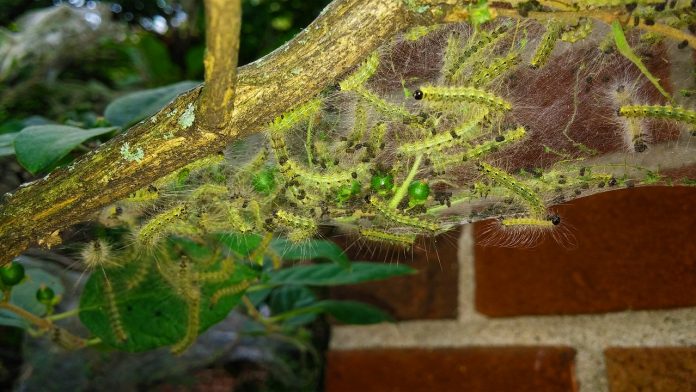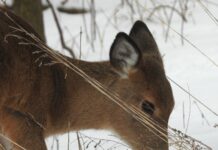It’s that time of year! Late summer is when we typically begin to see the beautiful large, light gray webs enclosing branch tips of a variety of trees.
As a child, I remember how much fun it was to take sticks and beat down the webs. The worms would come falling out, extremely agitated, I might add. This was all great fun as long as they didn’t land on you.
Ironically, this may have been one of the best things we could have done for the tree.
Many of you may also have great memories of your parents or grandparents putting a corn cob on the end of a stick, lighting it and catching the webs on fire. The anticipation of the “poof” was entertainment in itself… who needed video games then?
Fall webworm
The fall webworm is native to North America and is common from Canada into Mexico. It is one of the few American insect pests that have been introduced into Europe and Asia. It is common all across Ohio, though it seems to have major outbreaks every few years. In our area of the state, it appears this is our year.
Webworms will feed on more than 100 different species of trees in North America. Pecan, walnut, American elm, hickory, fruit trees and some maples are the preferred hosts in most of Ohio. Persimmon and sweet gum are all readily attacked in southern Ohio while willow, cottonwood, and alder are only occasionally attacked.
Pests
Even though these pests usually cause very little long-term damage, most gardeners hate them. This pest usually eats leaves late in the season and nests are generally concentrated to limited areas. Because of this, little real damage is done to most trees. However, the nests can look very unsightly and multiple generations in long summers can lead to significant defoliation.
Fall webworms have two generations each year and feed on a wide variety of shade trees. Wintering in cocoons in sheltered areas, the adult is a white moth that deposits several hundred eggs on the undersurface of leaves in June. These eggs are almost always laid on leaves near the tips of branches.
The eggs hatch in about a week and the small mass of caterpillar’s web over single leaves and feed by skeletonizing. They protect themselves from predators by keeping themselves covered with webs.
In mid-July, these caterpillars make cocoons in the webs. In late July, a new generation of moths comes from these cocoons and lays even more eggs on the trees.
By the time the end of August rolls around, trees are just covered with webs. Feeding will continue and webs will continue to grow until mid-September.
Predators
Right now, in August, there is nothing you can do. The good thing is that over 86 different predators prey on webworms, so natural controls are normally effective. Parasitic flies, stink bugs, birds, and social wasps (yellow jackets and paper nest wasps) are the most important predators.
Most gardeners prefer to prune the webs out of trees as well.
While many may believe that burning is the answer, it can also be dangerous and do additional damage to the tree. Insecticides are effective as well when treatments are made at the right times. Spraying in early spring and then again around June will generally keep the webworms in check.
So, don’t be alarmed by the sudden blossoming of webs. In most cases, Mother Nature will take care of it.
Eventually beneficial organisms will bring the webworms back to a more tolerable level. In the more severe cases, just make sure that next spring the tree gets plenty of water to produce healthy leaves and new growth. With a good start the tree should be able to recover.
Hopefully, next spring we will have much less of a problem.














This has been very helpful.
They are actually called Eastern Tent Caterpillars.
Ken, Eastern Tent Caterpillars typically can be found in fruit trees and ornamentals. This web worm is typically found in nut trees (hickory, pecan, etc.).
Very helpful, Thank you– They are in our Rosebud tree, only slightly so far. will let them go and see what happens next year. Dave
We have noticed the unsightly “spider-webs” in so many trees where we live. Now they are gone! Where are they now; no “webs”; no bugs; no caterpillars; are they butterflies? or moths? We don’t see anymore of the webs!?
Thank you for your time.
i have webs from the ground to the top in 2 of my ash trees in my yard what should i do with them ? have consider cutting them down but unsure
This information has been very helpful! In the North Georgia Mountains (spec. Jasper GA) there are quite a few branches covered. It helps to know that they may be gone next year. I cannot do anything about these trees because they are not mine, because they are growing alongside several roads in my area. Roger, I hope that you don’t have to cut down your trees — from what I learned in the article above, maybe next year they will be okay. I hope so, as I hope also for our trees to look prettier next year. Jill’s comment gives me hope also that they may be gone next year!